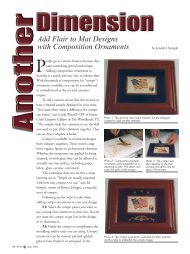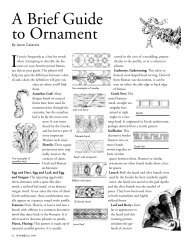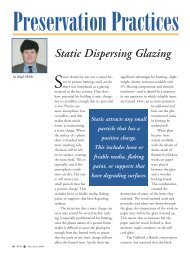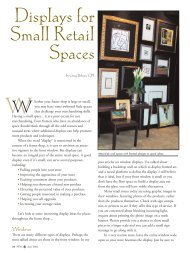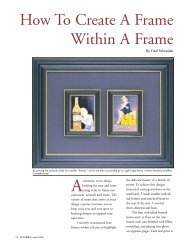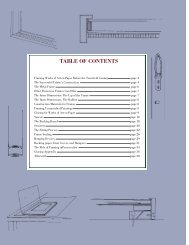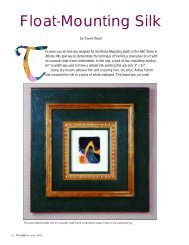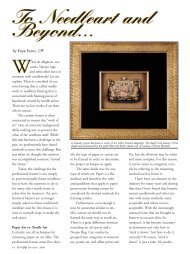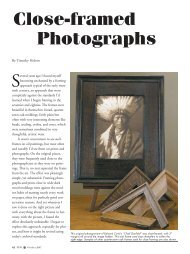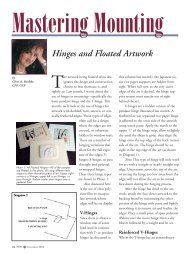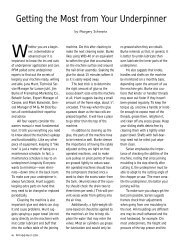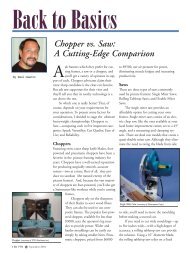PICTURE FRAMING MAGAZINE Ornamentation In Frame Design
PICTURE FRAMING MAGAZINE Ornamentation In Frame Design
PICTURE FRAMING MAGAZINE Ornamentation In Frame Design
Create successful ePaper yourself
Turn your PDF publications into a flip-book with our unique Google optimized e-Paper software.
Marcus Vitruvius Polio (90-20 B.C.E.),<br />
known simply as “Vitruvius,” said it best:<br />
“Good architectural design is composed of<br />
three important qualities: strength, utility,<br />
and aesthetic effect.” (<strong>In</strong> his 1624 translation,<br />
Sir Henry Wooton (1568-1639) quaintly<br />
changed this to “Firmness, Commodity, and<br />
Delight.”) The rule applies to framemaking as<br />
much as it does to architecture.<br />
Since the decorative arts arise from architecture,<br />
it stands to reason that the same standards<br />
apply to the design and construction of<br />
picture frames. A frame must be fabricated<br />
from well-seasoned and stable wood, with<br />
corner joints that are appropriate for the<br />
width and shape of the moulding. A frame<br />
must be fabricated of quality materials so that<br />
it will be equal, if not superior, to the quality<br />
of the painting; thus, it will show the<br />
painting to its best advantage. Lastly, a frame<br />
must be aesthetically pleasing in terms of its<br />
coloration, texture, and variety of sheens.<br />
Color is used to bolster the advancement or<br />
recession of forms and to differentiate<br />
elements.<br />
Vitruvius’ principle of consistency is also<br />
an important concept that applies to framing.<br />
For example, he writes:<br />
....temples of the Doric order are erected to<br />
Minerva, Mars, and Hercules, on account of<br />
whose valour their temples should be of masculine<br />
proportions, and without delicate ornament.<br />
The character of the Corinthian order<br />
seems more appropriate to Venus, Flora, Proserpine,<br />
and Nymphs of Fountains; because its<br />
slenderness, elegance and richness, and its orna-<br />
From top: acanthus leaf, guilloche, leaf and<br />
berry, and shell ornamentation designs.<br />
mental leaves surmounted by volutes, seem to<br />
bear an analogy to their dispositions...<br />
Vitruvius’ virtuoso books remind us that<br />
a good framer possesses historical knowledge<br />
of frame styles and ornamentation as they are<br />
appropriate, respectively, to the styles of<br />
painting. Eventually, the designer must<br />
know what works and what fails, and be able<br />
to articulate the reasons why.<br />
Learning the Language of Ornament<br />
When it comes to trying to identify various<br />
frame styles the amount of overlapping and<br />
conflicting information makes the task<br />
formidable. Armed with a little practice,<br />
experience in making sketches of profile<br />
drawings, and a firm understanding of the<br />
historically correct ornaments that are<br />
applied to them—their names, origins, and<br />
evolutions—one slowly develops an eye for<br />
the nuances and subtleties that emerge from<br />
the vast labyrinth of design information.<br />
Eventually, this “design vocabulary” of<br />
elementals leads the framer to develop<br />
“sentences,” “paragraphs,” and eventually a<br />
“novel” worthy, at best, of a place of honor<br />
in the mythological “Hall of <strong>Frame</strong>s” on<br />
Mount Olympus. (Or at least a new frame<br />
design that won’t be rejected by your<br />
discerning clients.) ■<br />
William B. Adair received his B.F.A. in Studio Art from the University of Maryland in 1972. For the next 10 years he worked for the<br />
Smithsonian <strong>In</strong>stitution’s National Portrait Gallery as a museum conservator specializing in the treatment of picture frames. <strong>In</strong> 1982 he<br />
formed his own company, Gold Leaf Studios, for the making of frames and the conservation of gilded antiques. Over the years his clients<br />
have included the U.S. Department of State and the National Park Service. He is the founder of the <strong>In</strong>ternational <strong>In</strong>stitute for <strong>Frame</strong><br />
Study, a non-profit archive dedicated to collecting and disseminating information on the history of frames. He can be reached via e-mail at<br />
bill@goldleafstudios.com.<br />
February 2004



